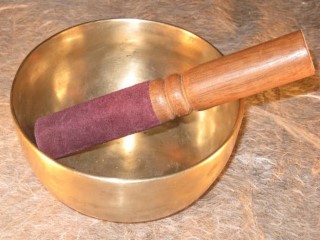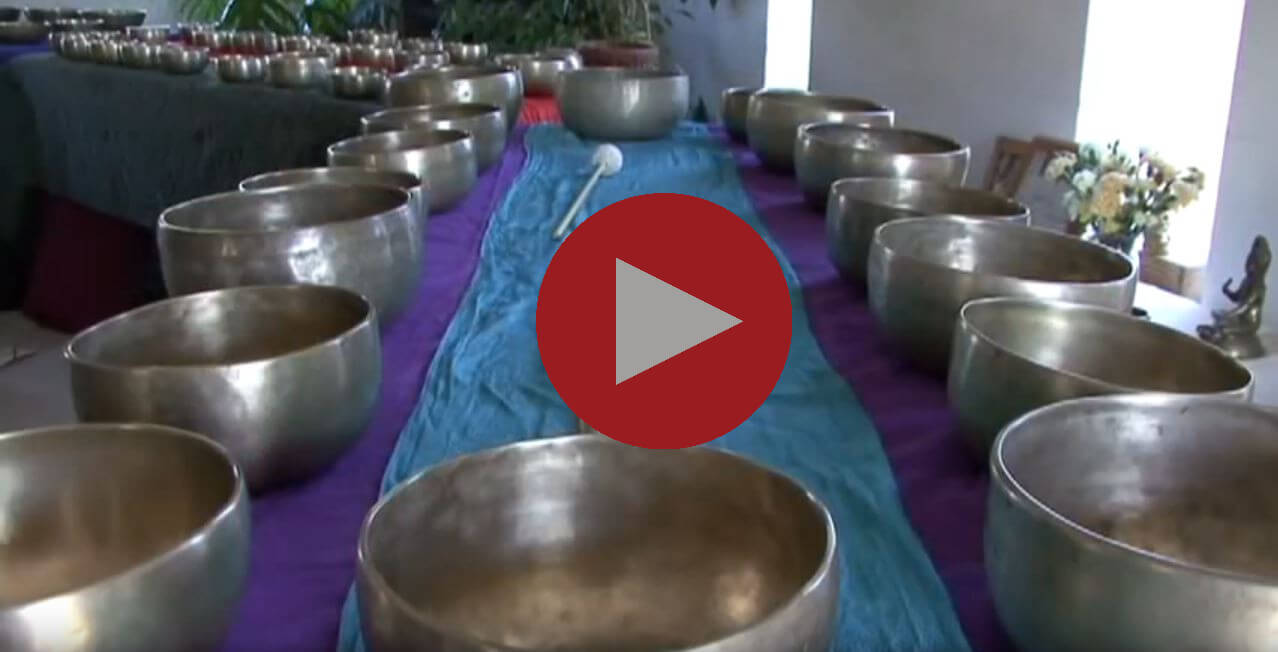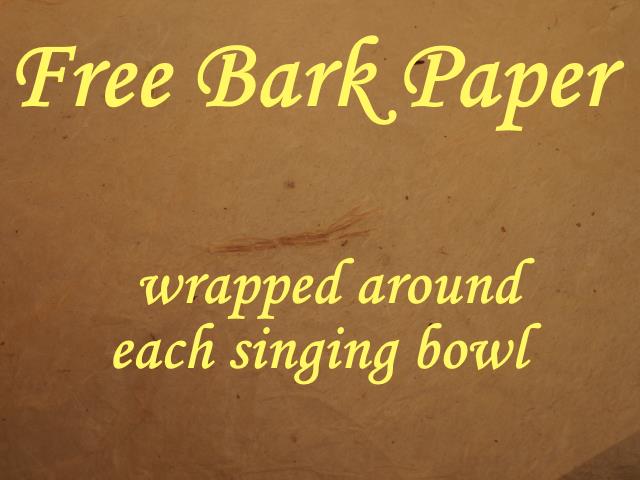Using Mallets With Your Singing Bowls
Premium quality singing bowls have two, three or even four main tones as well as other subtle sounds. You can bring out these different sounds by using different ringing instruments and techniques. Choice of singing bowl mallets and striker tools are an important part of the sound you hear and I’ve put a lot of attention to them.
Mallets allow you to listen to the subtle sounds. Once you get to know a singing bowl you can strike it at regular intervals to bring out one or another major tone. Of course big mallets can bring out powerful sounds from a large singing bowl. Mallets also allow you to ring an array of singing bowls rather than one at a time like ringing sticks. I like to have a few different mallets on hand to ring groups of singing bowls in quick succession. The long handles on the professional mallets allow you to ring singing bowls at a distance.
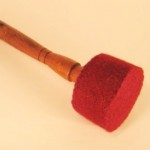
Most people who sell singing bowls sell mallets from Asia. These mallets are best for whacking a medium and larger bowls and getting out the big sounds. They are relatively soft and so they go well with deep bowls. Big mallets lend themselves to getting a rhythm going. The mallets made in Nepal do a very good job on Jambati singing bowls and the larger Thadobati provided what you are aiming for is the fundamental (deepest) tone. The wide striking surface of these singing bowl mallets helps transfer more of the energy from the mallet into the bowl.
Nepali mallets are significantly less expensive than the American ones despite being much larger. They can vary some in hardness, size, shape, even handle length. We carry five sizes of Nepali mallets which cover the range of singing bowl sizes. The smallest one we have made specially for Best Singing Bowls. Buy Nepali Mallets
Imported All Purpose Mallet
Small and light bowls require a mallet light enough to bring out sound yet small enough not to push the bowl around. Our exclusive all purpose mallets are a fine inexpensive option. The singing bowl striker is on the medium to hard side 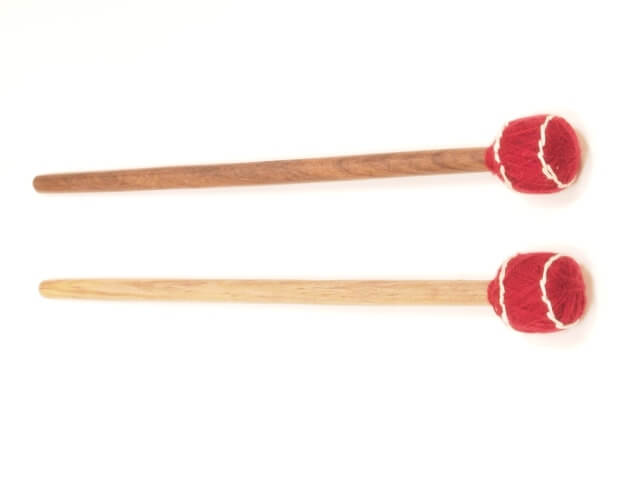 so it plays bowls brightly, both primary tone and overtones. We have two sizes of these mallets, one for very small bowls and one for slightly larger ones. The proper size is listed under recommended accessories for each bowl. When you order we make sure the right size is selected, and will adjust if needed Buy all purpose mallet: small medium
so it plays bowls brightly, both primary tone and overtones. We have two sizes of these mallets, one for very small bowls and one for slightly larger ones. The proper size is listed under recommended accessories for each bowl. When you order we make sure the right size is selected, and will adjust if needed Buy all purpose mallet: small medium
Precision American Made Mallets
The venerable Musser company stopped making the Tibetan singing bowl mallets we sold for many years back in 2015. ![]() In their place we developed our own Best Singing Bowls mallets. The is the first and only line of precision mallets developed specifically to take advantage of the unique characteristics of singing bowls. Our high quality mallets are made in the USA to exacting standards of consistency. We went through quite a development process to put together our set, dozens of samples from multiple manufacturers. in the end we could not buy the off-the-shelf offerings to get the exact performance we were looking for. Our mallets are unique and exclusive.
In their place we developed our own Best Singing Bowls mallets. The is the first and only line of precision mallets developed specifically to take advantage of the unique characteristics of singing bowls. Our high quality mallets are made in the USA to exacting standards of consistency. We went through quite a development process to put together our set, dozens of samples from multiple manufacturers. in the end we could not buy the off-the-shelf offerings to get the exact performance we were looking for. Our mallets are unique and exclusive.
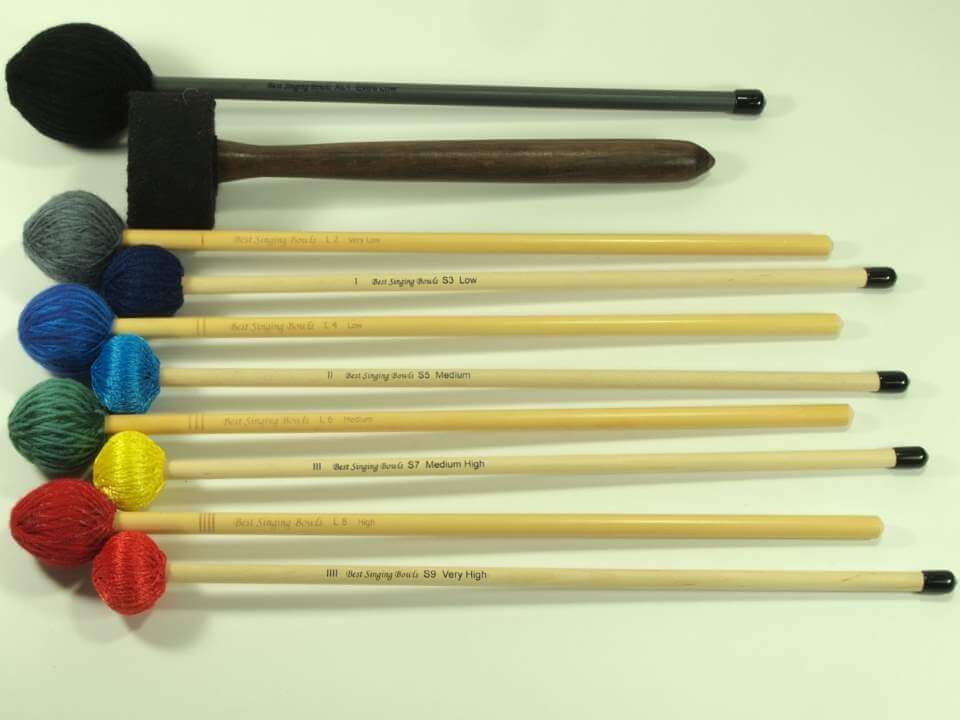
 The Best Singing Bowls mallet series add a whole other dimension to the experience of listening to singing bowls. Every singing bowl has a rich and varied soundscape waiting to be revealed. Our precision mallets are designed to bring out this full potential in a way a stick or basic tapper simply cannot.
The Best Singing Bowls mallet series add a whole other dimension to the experience of listening to singing bowls. Every singing bowl has a rich and varied soundscape waiting to be revealed. Our precision mallets are designed to bring out this full potential in a way a stick or basic tapper simply cannot.
Singing bowls have a fundamental tone, their place in the sound spectrum. Matching a Tibetan singing bowl mallet to this sweet spot is the best way to bring out the full native power of a bowl.
Singing bowls are not just one note, they all have many overtones. By selecting mallets above and below the native tone of a bowl we get to hear something very different from the same bowl. The way the mallets do this is by dampening some frequencies and exciting others.
The Best Singing Bowls mallet series has four mallets for smaller bowls and five for larger. If you listen closely you will be able to hear these four or five different soundscapes from any singing bowl. The mallets for smaller bowls are tuned a little higher than those for larger ones so the series has nine distinct tones.
Mallets designed for larger bowls have larger heads and a slightly oval shape for greater contact area. Smaller singing bowl striker tools are lighter and shaped for more easily making contact in a small area.
The performance of a mallet is a combination of the hardness of the underlying rubber and the nature of the covering material. We use softer natural wools for the lower notes and larger bowls, with cord and acrylic for higher tones and smaller bowls. Some mallets are blends of fibers, some have more layers of yarn than others.
The handles are an important part of how a mallet interacts with a bowl. Our handles are designed for the proper length, long enough for easy play without the excessive length of xylophone and marimba mallets. Proper length means you can play a single bowl easily in your hand or reach a group of bowls for a sequence of sounds. The material of the handles is important, flexible rattan for larger bowls and stiffer birch for smaller sizes.
One of the most important features of our precision mallets is the minimization of what musicians call “attack” which is the harsh sound made by contact when the bowl is struck. You can really hear attack if you strike a bowl with a ringing stick. Our mallets have been designed to generate a minimum of attack while still allowing the transfer of energy from your hand to the bowl. The combination of the shape of the head, materials used, flexibility in the handle and the core technology underneath it all is what provides this premium performance
![]()
In designing our new line we wanted to make picking up the right mallet intuitive so we matched the spectrum of sound to the spectrum of the rainbow. High tone mallets are colored high frequency red while low tone mallets are colored a cool blue. The mallets are also labeled with the tones they are designed for and numbered 1 to 9, low to high. Buy the ultimate singing bowl mallet set
Our small precision mallets have small lightweight heads and stiff natural birch wood handles. The range in  tone from low to very high (hardness from soft to hard). The deepest tone mallet is the S3 with deep blue pure wool yarn. The materials change on the S5 shown to the right, bright blue for a somewhat higher tone. The S7 mallet is tuned to the middle and upper parts of the upper parts of the 4th octave. It is colored bright yellow, to indicate its higher tone. The highest tone small mallet is for 5th octave play and overtones, it is colored hot red and uses tightly wound cord. Keep in mind your singing bowl has a varied soundscape. Even if it is a lower tone bowl using a higher tone mallet will provide a different sonic experience. Any bowl will benefit from more than one percision mallet.
tone from low to very high (hardness from soft to hard). The deepest tone mallet is the S3 with deep blue pure wool yarn. The materials change on the S5 shown to the right, bright blue for a somewhat higher tone. The S7 mallet is tuned to the middle and upper parts of the upper parts of the 4th octave. It is colored bright yellow, to indicate its higher tone. The highest tone small mallet is for 5th octave play and overtones, it is colored hot red and uses tightly wound cord. Keep in mind your singing bowl has a varied soundscape. Even if it is a lower tone bowl using a higher tone mallet will provide a different sonic experience. Any bowl will benefit from more than one percision mallet.
Nothing beats these small mallets for delivering the kind of firm gentle tap you need for ringing petite bowls. For really tiny Manipuri singing bowls a light tap with the hardest cord mallet is often the way to get the most sound out. Smaller Thadobati singing bowls with rounded bottoms are also perfect, again because you can get the sound out without pushing the bowl around. These mallets are versatile and can be used on bowls up to about 6 inches. The long birch handle on these mallets give you the ability to be in a comfortable position and reach out to the bowl.
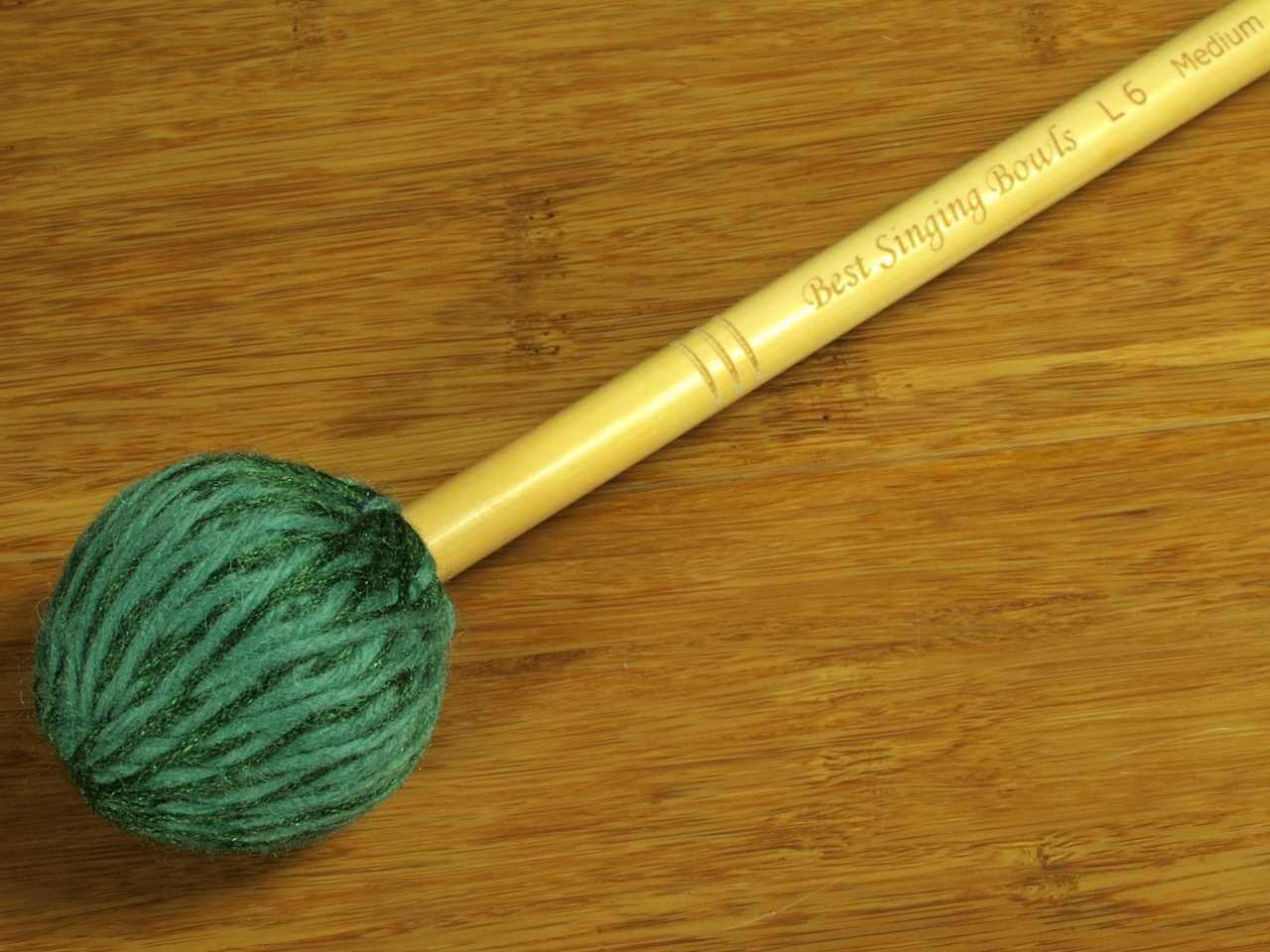 Best precision large mallets have larger heavier heads and more flexible natural rattan handles. They range in tone from very low to high (hardness from soft to hard). The extra mass allows you to strike the singing bowl harder with good effect and less of what musicians call “attack”, the compressed soundwave caused by the initial contact with the bowl. The long rattan handle on these mallets gives you the ability to be in a comfortable position and reach out to the bowl. These sound bowl mallets can be used on all bowls over about 5 inches.
Best precision large mallets have larger heavier heads and more flexible natural rattan handles. They range in tone from very low to high (hardness from soft to hard). The extra mass allows you to strike the singing bowl harder with good effect and less of what musicians call “attack”, the compressed soundwave caused by the initial contact with the bowl. The long rattan handle on these mallets gives you the ability to be in a comfortable position and reach out to the bowl. These sound bowl mallets can be used on all bowls over about 5 inches.
The highest tone mallet in the series is L8 which has a mixture of yarns and is colored a hot red. It is spectacular at playing the upper registers of large thick bowls, especially effective for the sharp highs on thick Mani and Thadobati. The L6 shown to the left is the most popular in the large series, higher tones but not the top of the range. It is colored green following ROYGBIV down the color scale. The blue L4 is toned a bit deeper, good in the third octave. The lowest tone mallet in the series the grey L2 has a larger head and pure wool construction for the deepest Thadobati and Manipuri bowls along with some Jambati style..
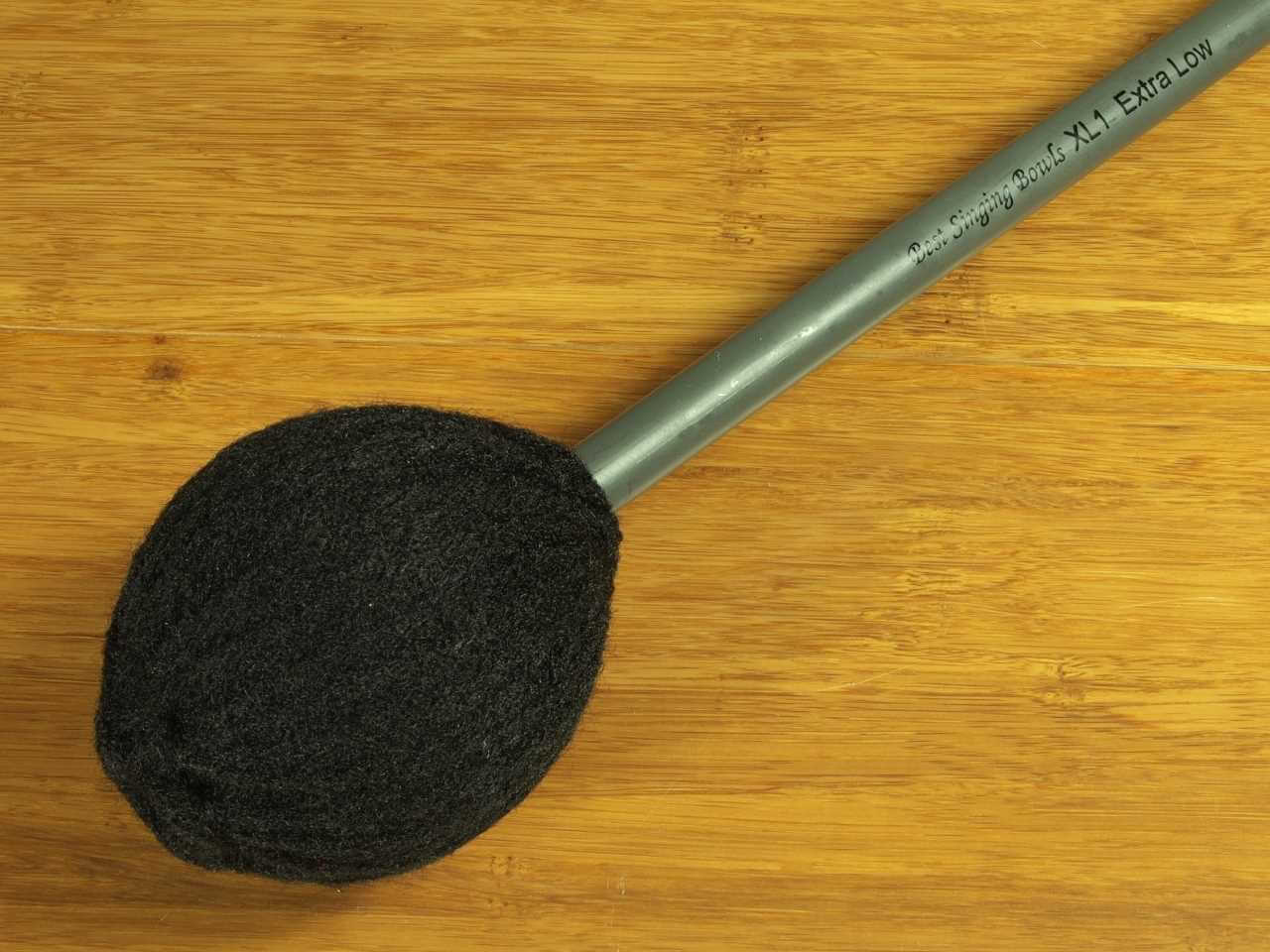
In order to play the deepest tones from a bowl special construction is required. When playing the bottom of the soundscape, especially in a large bowl you have a dynamic tension between bringing out the deep tone and bringing out the most sound. For the deepest tone The XL 1 pictured to the right is uniquely engineered for dampening all but the fundamental tone of a low tone bowl. It is incredibly soft, even spongy and covered with a loosely would very soft pure wool. It is colored black, as deep ass you can go. When playing with this mallet volume is limited. It is an inevitable trade-off for being able to focus so directly on a deep fundamental. The mallet is large enough for even the biggest singing bowls. It only works best on bowls, say over 10 inches in general and as “small” as 8 inches if the bowl is in the second octave. The handle is a bit longer to accommodate the larger sizes of the bowls it is designed for. Buy the XL 1
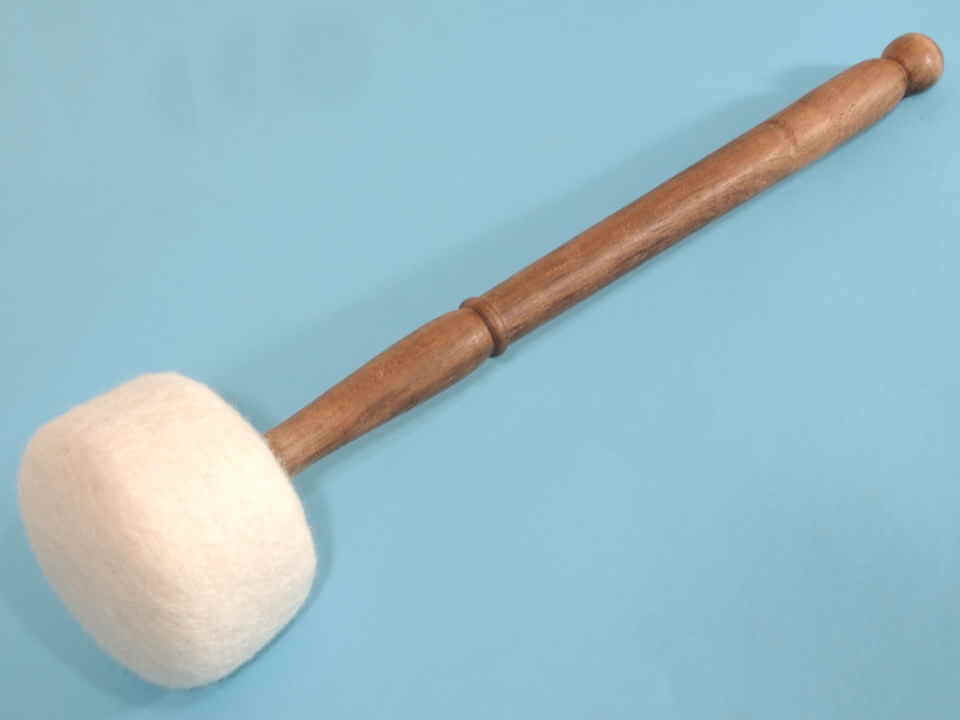
Our other specialty sound bowl mallet for deepest tone play is the L1 pictured to the right. It is a large fluffy white mallet made of layers of felt. It has a thick contoured wooden handle. Despite the name it is larger and heavier and therefore can deliver more power to a big deep bowl. This is the mallet to use for maximum deep tone volume. Buy the L 1
Both of these mallets are different from the Nepali felt mallets which come in various sizes including the huge N88. All of those mallets are constructed in such a way that you get the bass but also some part of the higher level notes.
Wood and Leather/Suede Ringing Sticks and Mallets for Singing Bowls
One of the things that sets the quality you’ll see on this website apart is the range of tones in each singing bowl. Choice of mallets and sticks are an important part of the sound you hear and I’ve put a lot of attention to them.
If you want to hear your singing bowls wail then ringing sticks are the way to go. When you use a ringing stick try to keep your wrist in one position and move your arm around the singing bowl. This gives you the ability to maintain the same angle of contact all the way around the rim. Even pressure is important so you maintain contact with the edge of the singing bowl. Angle and consistency of contact is key with ringing sticks – especially with high-end large singing bowls. With multi tonal Jambati singing bowls changing the angle of the ringing stick allows you to bring out different tones. A vertical angle (perpendicular to the side of the singing bowl) will bring out the low tones while tipping the stick towards horizontal will ring the singing bowl high.
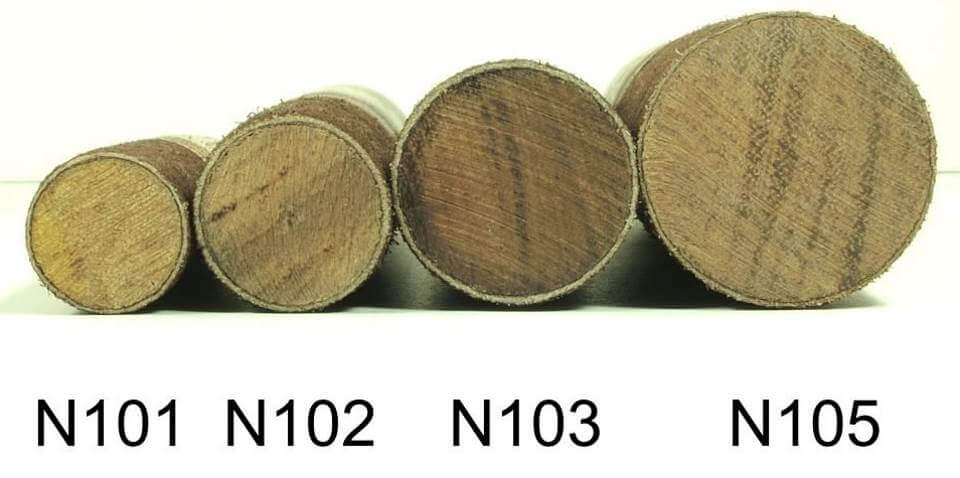

The material in a ringing stick makes a big difference. Wood sticks are best for bringing out the high tones, leather is best for low tones. A lot of people sell felt sticks but I find them hard to use on most singing bowls and have declined to sell them [sorry, vegans]. The type of wood is also important. The Nepalese sticks are made of a hard wood which can be unforgiving in an inexperienced hand. In other words they can bounce off the singing bowl easily and you end up hearing a squeal. I try to buy the softest of the hard Nepalese wood (I reject sticks made of heartwood). These sticks are good but they are not optimal. I’ve been experimenting with different woods (Mitch Nur swears by Aspen) and at some point I hope to offer an alternative wood stick.
The size of a ringing stick should be in proportion to the size of the singing bowl. Tiny singing bowls really need a tiny stick for the best play. Interestingly, when I got to Nepal I found that the largest sticks were (in my opinion) too small for the biggest singing bowls and so I had a larger size made especially for me.
One thing I really like about the thick Mani singing bowls is that you don’t have to go all the way around the rim to get out the full sound. A quick back and forth motion with wood quickly brings up the tones in these bowls. Occasionally a very thick Thalobati or Jambati singing bowl will play this way. When I can, I use this method in sound clips.
You’ll notice that I don’t sell sticks with carvings and Buddha heads (not sure he likes to sit above a piece of leather, anyway), instead, mine are neatly cut off at the top. This is on purpose, contact near the end of the stick is best for ringing and the ornamentation gets in the way of good playing. There is a bit of decorative flair in the middle of the sticks where it won’t get in the way.
Buy Ringing Sticks
Tapping a singing bowl with a ringing stick can be used as an alternative to a sound bowl mallet. You have a lot less control with a stick and really no choice of hardnesses. I’m not a fan.
Frank Perry hand turned heritage wood wands
Frank Perry has one of the oldest and largest antique 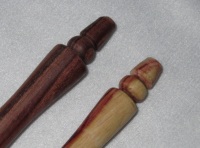 singing bowl collections in the United Kingdom. Frank is a master at bringing out individual tones from bowls. One of his secrets are the many different wands he makes using a wide variety of woods. Frank is a craftsman, he starts with wood blanks and hand turns pieces on a lathe at his home in the south of England. These are beautiful exquisitely finished pieces each with his signature top pictured to the left.
singing bowl collections in the United Kingdom. Frank is a master at bringing out individual tones from bowls. One of his secrets are the many different wands he makes using a wide variety of woods. Frank is a craftsman, he starts with wood blanks and hand turns pieces on a lathe at his home in the south of England. These are beautiful exquisitely finished pieces each with his signature top pictured to the left.
Over the years Frank Perry has experimented with all kinds of wood, from odd pieces scavenged from fallen branches to fine woods imported from around the world. Best singing bowls has a selected a variety of woods in two sizes that can bring out the full range of sounds from the rather diverse universe of singing bowls. One thing to keep in mind about the wands or any around the rim ringing implement is that the interaction with the bowl is a complex one. A bowl will ring great with one wood and not well at all with another. Still wands and bowls have general characteristics which are listed below.
All the woods we sell are certified sustainably harvested in the UK and are not endangered or threatened species. This is important, as even a relative splinter like these wands are can contribute to ecological degradation and human suffering if they come from over harvested or poached trees.
The wands come in two sizes, tiny and “massive”. The tiny wands are only six inches long and no more than half an inch in diameter – but they are very powerful. Unlike the Nepali ringing sticks one of Frank’s tiny wands can bring incredible sounds out of the largest singing bowl. The massive wands, 15 to 30 times the weight of the tiny ones, are easy to use. Their weight naturally presses against the rim, and they are best for larger bowls, 6 inches and above.
The Woods: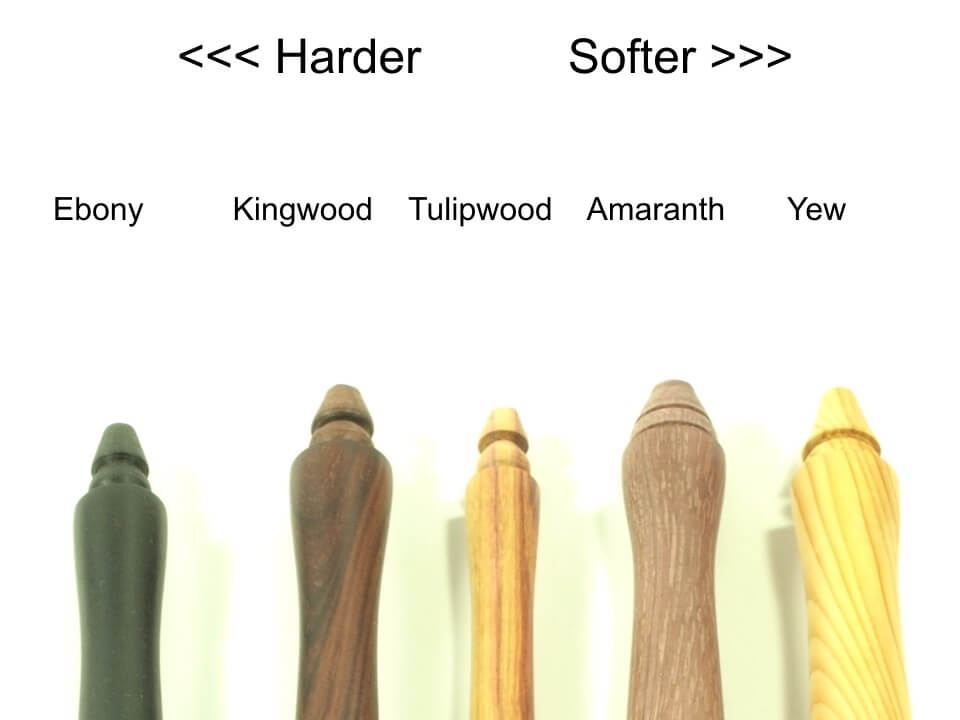
Sacred Yew – All over England you will see Yew planted by the old churches surrounded by headstones – and even around pre-Christian sites. The wands have a creamy color with a light grain. Yew is a soft, relatively light and flexible wood. These characteristics give it the ability to play the deeper tones in singing bowls. The softness and flexibility of yew allows this wand to play rougher edges quietly. We offer Yew in both mini and massive sizes.
Purple Amaranth – comes from Central and South America. The wood is dense but flexible and also on the dry side so the finish is “rough” which gives the wand a better grip, especially for bowls with a very smooth edge. Amaranth is the most versatile of the mini wands. On bowls with a rough edge Amaranth can be a bit noisy.
Tulipwood – is a beautifully colored rosewood from a small tree native to northeastern Brazil.. The wood is dense with moderate hardness. Tulipwood can sometimes ring bowls that do not respond to very hard or very soft wands.
Kingwood – is a dense, strong and hard wood that grows in Mexico and Brazil. It is the second hardest wood we sell, not quite as hard as ebony and sometimes will ring a lower overtone than ebony does on the same bowl. Kingwood wands are smooth with a rich brown wood and dark contrasting grain.
Ebony – is a hard, dense and very stiff wood that can be polished to a very smooth finish. These characteristics give ebony the ability to tease out the highest sounds from a wide range of singing bowls. The wood is black with occasional hints of dark brown and is heavy in your hand. True Ebony comes from equatorial West Africa and is an over exploited and endangered species. The ebony we use is technically “African blackwood” from central and southern Africa. This wood is not listed as endangered by either of the worldwide wood sustainability indices CITES or IUCN. For singing bowls African blackwood is actually better than true ebony, it is denser and harder which makes it better for teasing out the very highest of tones.
Vermilion – has a warm reddish color, hence the same name as the deep red pigment made from cinnabar, an alloy of mercury. Also known as “Paduk” it comes from West Africa. The wood is a hard and dense wood with moderate flexibility. These characteristics give it the ability to tease out sound, especially higher tones, from a wide range of singing bowls. Vermillion is the most versatile of the massive size wands.
Zebra wood – or “Zebrano” is a deeply striped wood from West Africa. It is a hard, dense and inflexible. These characteristics make it best for teasing out the higher tones from singing bowls. The smooth finish of Zebrano wands also helps with those high notes. Zebra wood comes from West Africa. It is not an endangered or threatened species.
Best for low tones – Sacred Yew
Best for high tones – Kingwood, Ebony and Zebra.
Best for tough to play bowls – Purple Amaranth
Versatile wands for many bowls – Tulipwood and Vermillion













